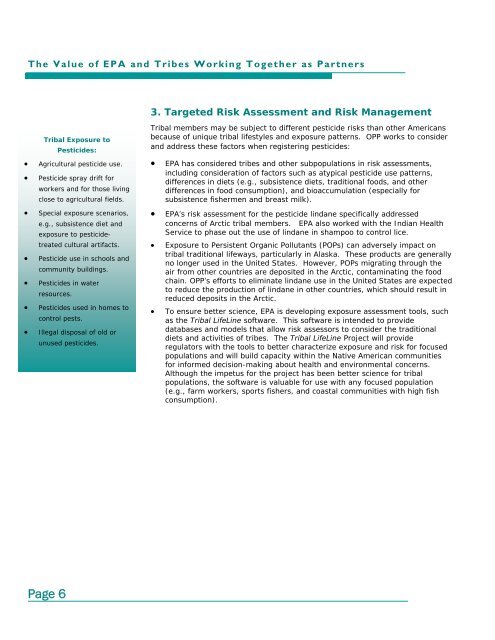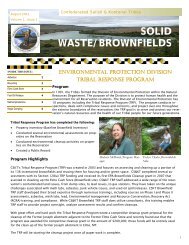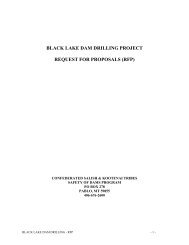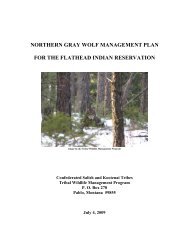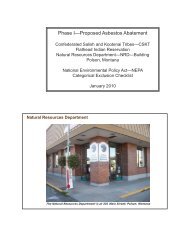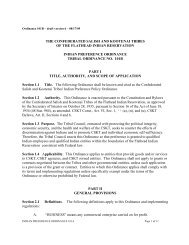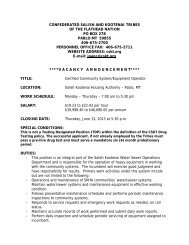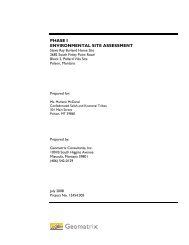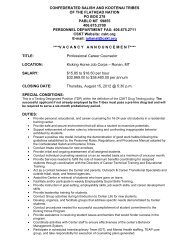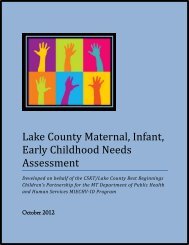US EPA - The National Pesticide Tribal Program - US Environmental ...
US EPA - The National Pesticide Tribal Program - US Environmental ...
US EPA - The National Pesticide Tribal Program - US Environmental ...
You also want an ePaper? Increase the reach of your titles
YUMPU automatically turns print PDFs into web optimized ePapers that Google loves.
<strong>The</strong> Value of <strong>EPA</strong> and Tribes Working Together as Partners<br />
3. Targeted Risk Assessment and Risk Management<br />
<strong>Tribal</strong> Exposure to<br />
<strong>Pesticide</strong>s:<br />
• Agricultural pesticide use.<br />
• <strong>Pesticide</strong> spray drift for<br />
workers and for those living<br />
close to agricultural fields.<br />
• Special exposure scenarios,<br />
e.g., subsistence diet and<br />
exposure to pesticidetreated<br />
cultural artifacts.<br />
• <strong>Pesticide</strong> use in schools and<br />
community buildings.<br />
• <strong>Pesticide</strong>s in water<br />
resources.<br />
• <strong>Pesticide</strong>s used in homes to<br />
control pests.<br />
• Illegal disposal of old or<br />
unused pesticides.<br />
<strong>Tribal</strong> members may be subject to different pesticide risks than other Americans<br />
because of unique tribal lifestyles and exposure patterns. OPP works to consider<br />
and address these factors when registering pesticides:<br />
• <strong>EPA</strong> has considered tribes and other subpopulations in risk assessments,<br />
including consideration of factors such as atypical pesticide use patterns,<br />
differences in diets (e.g., subsistence diets, traditional foods, and other<br />
differences in food consumption), and bioaccumulation (especially for<br />
subsistence fishermen and breast milk).<br />
• <strong>EPA</strong>’s risk assessment for the pesticide lindane specifically addressed<br />
concerns of Arctic tribal members. <strong>EPA</strong> also worked with the Indian Health<br />
Service to phase out the use of lindane in shampoo to control lice.<br />
• Exposure to Persistent Organic Pollutants (POPs) can adversely impact on<br />
tribal traditional lifeways, particularly in Alaska. <strong>The</strong>se products are generally<br />
no longer used in the United States. However, POPs migrating through the<br />
air from other countries are deposited in the Arctic, contaminating the food<br />
chain. OPP’s efforts to eliminate lindane use in the United States are expected<br />
to reduce the production of lindane in other countries, which should result in<br />
reduced deposits in the Arctic.<br />
• To ensure better science, <strong>EPA</strong> is developing exposure assessment tools, such<br />
as the <strong>Tribal</strong> LifeLine software. This software is intended to provide<br />
databases and models that allow risk assessors to consider the traditional<br />
diets and activities of tribes. <strong>The</strong> <strong>Tribal</strong> LifeLine Project will provide<br />
regulators with the tools to better characterize exposure and risk for focused<br />
populations and will build capacity within the Native American communities<br />
for informed decision-making about health and environmental concerns.<br />
Although the impetus for the project has been better science for tribal<br />
populations, the software is valuable for use with any focused population<br />
(e.g., farm workers, sports fishers, and coastal communities with high fish<br />
consumption).<br />
Page 6


